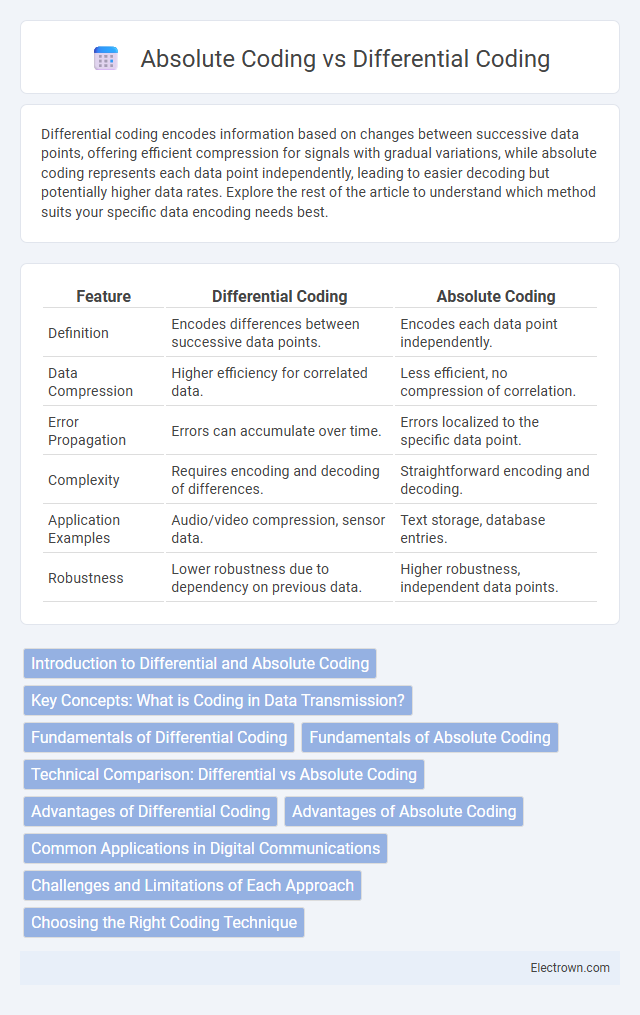Differential coding encodes information based on changes between successive data points, offering efficient compression for signals with gradual variations, while absolute coding represents each data point independently, leading to easier decoding but potentially higher data rates. Explore the rest of the article to understand which method suits your specific data encoding needs best.
Table of Comparison
| Feature | Differential Coding | Absolute Coding |
|---|---|---|
| Definition | Encodes differences between successive data points. | Encodes each data point independently. |
| Data Compression | Higher efficiency for correlated data. | Less efficient, no compression of correlation. |
| Error Propagation | Errors can accumulate over time. | Errors localized to the specific data point. |
| Complexity | Requires encoding and decoding of differences. | Straightforward encoding and decoding. |
| Application Examples | Audio/video compression, sensor data. | Text storage, database entries. |
| Robustness | Lower robustness due to dependency on previous data. | Higher robustness, independent data points. |
Introduction to Differential and Absolute Coding
Differential coding represents data as differences between successive values, which can reduce redundancy and improve compression efficiency in signal processing. Absolute coding encodes each data point independently, preserving exact values without reference to previous data, essential for applications requiring precise reconstruction. Understanding these encoding methods helps you select the optimal approach for balancing data size and accuracy in your communication or storage systems.
Key Concepts: What is Coding in Data Transmission?
Coding in data transmission refers to the process of converting information into a specific format for efficient and accurate communication. Differential coding encodes data based on changes between successive symbols, making it robust against signal distortion, while absolute coding transmits the exact data values independently. Understanding these methods helps optimize your communication system's reliability and error resilience.
Fundamentals of Differential Coding
Differential coding encodes information by representing changes between successive data elements rather than absolute values, enhancing robustness against transmission errors and reducing redundancy. This technique is widely applied in signal processing and communication systems to improve compression efficiency and error resilience. Its core principle relies on storing or transmitting differences, which often require fewer bits compared to absolute coding methods.
Fundamentals of Absolute Coding
Absolute coding encodes each data point as a distinct value, independent of previous entries, ensuring a direct and unambiguous representation of information. This method simplifies decoding processes since it does not rely on prior data to interpret the current value, making it ideal for systems requiring fast, error-resistant retrieval. Common applications include address encoding in memory storage and GPS coordinate transmission, where accuracy and clarity of each individual data point are critical.
Technical Comparison: Differential vs Absolute Coding
Differential coding encodes data based on the difference between successive values, reducing redundancy and improving compression efficiency compared to absolute coding, which encodes each value independently. Absolute coding is simpler and more robust to errors but often results in larger file sizes due to the lack of predictive context. Your choice between differential and absolute coding impacts storage requirements, error resilience, and computational complexity in data transmission or signal processing systems.
Advantages of Differential Coding
Differential coding offers significant advantages by encoding the difference between successive data points, which reduces redundancy and lowers the required transmission bandwidth. This method enhances error resilience, as minor transmission errors affect only the current sample rather than the entire data stream. Your communication systems benefit from improved compression efficiency and robust performance in noisy environments through differential coding.
Advantages of Absolute Coding
Absolute coding provides precise reference values for each measurement, ensuring clarity and reducing the risk of cumulative errors common in differential coding. This method is ideal for applications requiring exact positional information or where data integrity is critical over time. Your system benefits from faster error detection and simpler data interpretation with absolute coding.
Common Applications in Digital Communications
Differential coding is widely used in phase modulation schemes such as Differential Phase Shift Keying (DPSK) to combat phase ambiguity and improve error resilience in wireless communications. Absolute coding, often employed in pulse-code modulation (PCM), is common in digital audio and data storage systems where precise signal reconstruction is critical. Both coding techniques enhance data integrity but serve distinct purposes based on channel characteristics and application requirements.
Challenges and Limitations of Each Approach
Differential coding faces challenges including error propagation, where a single mistake can affect subsequent data decoding, and sensitivity to transmission errors that require robust error correction. Absolute coding, while less prone to cumulative errors, demands higher data rates and increased storage capacity due to the need to record full information for each data point. Your choice between these methods depends on balancing error tolerance with resource availability in communication or storage systems.
Choosing the Right Coding Technique
Choosing the right coding technique depends on the nature of data and application requirements; differential coding excels in compressing signals with small incremental changes by encoding differences between successive samples, reducing redundancy. Absolute coding is preferred when data values vary widely or require precise, standalone representation without error propagation. Efficient selection between differential and absolute coding optimizes storage, transmission bandwidth, and error resilience in communication and data compression systems.
Differential Coding vs Absolute Coding Infographic

 electrown.com
electrown.com